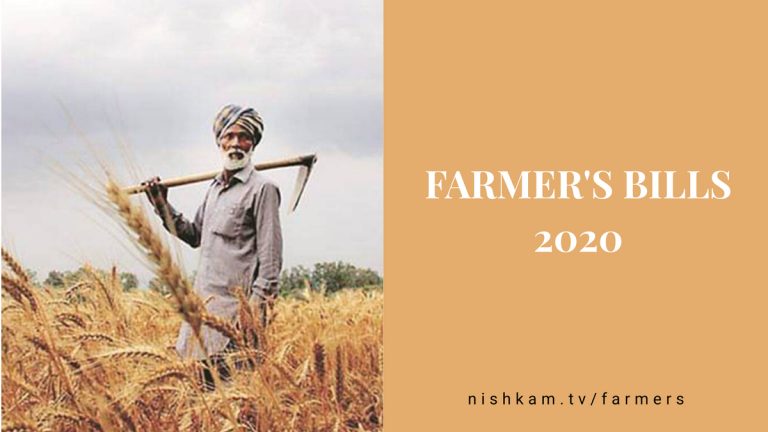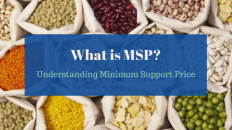India’s History of Famines and Farming
Imagine 19th century India under British colonial rule: The East India Company is running large-scale farming, producing opium and tea in northern and north-western India respectively at the expense of India’s hardworking farmers.
Now imagine an Indian government that is doing everything in its power to shut out the voices of the farming industry, leading to 500,000 farmers sitting down to protest against new agricultural laws in the Indian capital of Delhi and millions more participating in Bharat-bandh (India Shut down) strikes throughout India. Is history repeating itself? Before answering and discussing the exact cause of the issues leading to this protest, it is worthwhile to understand the history of Indian farming.
Before and during the 300 years of British rule, India was recognized by many names such as a land of riches, a land of mystics, and land of famines. During the 200-year period before India’s independence, approximately 100 million people had died due to starvation and food shortages that devastated India. The British looked to Punjab to solve the problem. They developed a modern canal system there and encouraged farming during the late 19th and early 20th centuries. Initially, the increase in production of essential food was a positive step forward for the people of Punjab. However, the British East India Company soon took advantage of their colonial footing and exploited the opium farmers in Bihar and Uttar Pradesh and the tea plantation workers in Assam and Bengal.
After India gained independence in 1947, the Nehru government prioritized industrialization over agricultural development. They capped food prices so that people in the cities were able to afford cheap food. However, the price cap came at a steep price for the farmers. Farmers were starved and the modernization of agriculture was essentially halted. In 1965, famine was imminent in India during the autumn months. This was known to Lester Brown, a young U.S. foreign policy aid in Delhi, who had analyzed monsoon patterns and crop data. No one else in India had seen it coming. Lester discussed the matter with the U.S. secretary of agriculture, Orville Freeman, who approached the US President, Lyndon Johnson. Eventually, more than 10 million tons of wheat, about one-fifth of entire US production, was shipped to India, the largest food grain shipment ever from the US to India. Sure enough, the fall crop in India was short of 18 million tons from the 95 million tons required.
Once the famine was averted, US officials worked with Indian counterparts to draft the country’s next agriculture policy. The main suggestions were to deregulate fertilizer production and encourage the use of modern farming techniques such as using fertilizers and pesticides. With help from US policy aids and another American scientist, Norman Borlaug, India focused on The Green Revolution for the next few years. The Indian government tried to convince many Indian states to adopt modern farming techniques. However, only the farmers of Punjab and Haryana agreed to experiment with the new methods. To guarantee the minimum price of main crops and to gain the confidence of the farmers, the government introduced Minimum Support Price (MSP) in Punjab and Haryana. As a result, within seven years, India doubled its wheat harvest and saved millions of lives from famine throughout the 1960’s and 70’s. Even today, Punjab and Haryana, together, contribute to 70% of the center government’s food distribution system and are considered to be the food bowl of India.
It is important to understand and contextualize the MSP (Minimum Support Price) when discussing India’s agricultural history. Essentially, The MSP is a pricing model based on production costs and reasonable returns. A similar costing model is used in many government contracts, including defense, healthcare and other industries within India, the United States, and other countries. It is also similar to India’s Pay Commission system in which the commission determines the fair wages of government employees based on several factors. Based on a study of income from 1970 to 2015, a farmer’s income has risen only 20 times whereas a government employee’s income has risen about 150 times.
The new agricultural policy, including modernization, better seeds, and MSP helped the country in achieving its self-sufficiency in grain production and helped the farmers of Punjab, Haryana and Western Uttar Pradesh for the short-term. On the flip side, the new policy has threatened the long-term sustainability of farming in Punjab as water levels have gone down by more than 200 feet, forest land has declined to less than 4%, and cancer rates among farmers have increased due to the heavy use of pesticides. Additionally, Punjab has also lacked in industrial development compared toother states in India such as Gujarat, Delhi, and Maharashtra. During the last three decades, while the Indian economy benefited from globalization; the farmers mainly suffered as the MSP couldn’t keep up with inflation and the farmer incomes were stagnated as a result. Consequently, farmers’ suicides have been rising throughout India, including Punjab. The Indian government knew they needed to help the farmers, as Mr. Modi himself promised to raise the MSP in his 2014 election manifesto.
What are the Controversial Farm Acts?
The President of India signed the following three farm bills into acts on September 27, 2020:
- The Farmers’ Produce Trade and Commerce (Promotion and Facilitation) Act,
- The Farmers (Empowerment and Protection) Agreement of Price Assurance and Farm Services Act, and
- The Essential Commodities (Amendment) Act.
In simple terms, Act 1 allows trading in traditionally “outside trade areas” such as farm gates, factory premises, warehouses, silos, and cold storage. Earlier, agricultural trade could only be conducted in the state-owned Agricultural Produce Market Committee (APMC) operated yards, called mandis. Act 2 creates a national framework for contract farming via mutual agreements between a farmer and a buyer before the harvest or production of any farm produce. Act 3 removes food grains, potatoes, onions and other perishable food from the list of essential items unless there is a war, famine or extraordinary situation.
The acts seem harmless or even progressive at first and the Modi government is claiming that these bills are for the benefit of the farmers, as farmers will now have much more freedom as they will be able to sell their produce outside APMC mandis. However, if one analyses the current farming practices and the financial condition of the farmers, they would find that there are no benefits for the farmers. Instead, the farmers are met with declining profits and abuse by the corporate sector. In looking at Act 1, we find that it cannot really benefit a farmer in a nationwide market due to his or her limited resources and practically no storage facilities. It can only benefit big corporations, which would buy the produce from farmers in one state at low prices and then sell it nationwide. Likewise, Act 2 is clearly meant to benefit the corporate sector who may contract thousands of acres of land (average farmer has only two acres of land) at low prices and then use heavy machinery and pricing power to control the prices of the crops. Finally, Act 3 may result in price gauging and monopolization of supply controls (Jamakhori a.k.a. hoarding), which will be bad for both farmers and consumers alike.
Objections to Farm Acts
The objections to the farm acts fall into two categories – the acts themselves and the process in which the acts were passed and signed into law. The main objections to the acts that fall into the first category are:
1. The acts will lead to the eventual closure of the government procurement system (mandi) and the end of the MSP prices, even though the acts don’t state it explicitly. Currently, a farming state like Punjab obtains its primary revenue via the taxes collected from the produce sold in the government mandi system. The new acts allow the corporate sector to buy directly from farmers and thus deprives the state of much needed revenue to maintain infrastructure. Initially, the farmers may benefit as some of the savings from the 8% tax that is currently paid to AMPC by the buyers will be passed on in higher prices. However, the mandi-system will collapse within a couple of years due to lack of revenue or trade. In 2006, the Indian government had implemented a similar system of abolishing state-owned procurement. in Biharas a model for the country. Fourteen years later, however, it has ultimately led to lower income for farmers and the deterioration in public infrastructure due to the lack of state revenues.
2. Once the state-owned procurement system and MSP is eliminated or set at unrealistically low levels, the prices of crops will only start falling downward. Again, the Bihar example clearly shows that the purchase price of rice grains from farmers has decreased by about 40% and the financial condition of farmers has worsened. Ironically, this has not led to any decrease in the food products sold to the consumer (e.g., wheat flour, rice). The additional profits are only kept by corporations. who can store the grains and manage the supply chains.
3. Contract farming will eventually kill the voices of farmers and turn them into laborers tilling their own land while others profit. The farmers will practically have no say in their own mutual agreements, as a farmer with an annual income of $1000 will not be able to afford lawyers to read or draft contracts against large corporations with revenues of more than a billion dollars. To understand the exploitation of farmers by contract farmers, we can look to the the East India Company’s detrimental contract farming on opium and tea plantations. (Refer to page 1 of this document)
4. The ‘dispute resolution clause’ in the acts takes away a farmer’ right to access the court system. The acts suggest approaching local bureaucrats instead, who may setup committees to resolve disputes between a farmer and a corporate house. With known rampant corruption in Indian government officials, this arrangement will only benefit the corporate sector who will likely bribe bureaucrats to resolve disputes in their favor while leaving the farmers helpless. Again, we can draw a comparison between today’s occurrences and the actions of the British bureaucrats in the 19th century who taxed tea plantations in order to kill all competition against the East India Company.
5. The removal of basic food grains from the list of essential products will lead to mass storage by big firms and the implementation of supply controls to artificially control the prices. This has been an issue in India in the past, and to address this problem, basic food items were added to the essential commodities list so that no one could manipulate the prices by controlling supplies. The “essential commodities” concept is applied in several other critical sectors such as healthcare. One may remember the case of a generic US drug, Daraprim in 2015. The company’s CEO,Martin Shkreli, jacked up its price overnight by 5,000 percent, from $13.50 a pill to $750 a pill. Another example of this is onion prices in India shot up to 10 times their normal rate in 2019 mainly due to the shortage and illegal hoarding by traders. This ugly side of capitalism may become worse if you apply it to basic and essential goods such as wheat and rice.6. Some advocates of the law give examples of free trade from other areas such as telecommunications and retail. It is necessary to understand that agriculture cannot be compared with such commerce as it is vital for the lives of the people and the sovereignty of the country. Critical industries such as defense and healthcare are always regulated and agriculture should be regulated as well. . In developed countries such as Europe and the United States, farmers receive direct payments to ensure sustainability. For context, India provides only 10% of the total income of farmers via subsidies whereas the US and many other developed countries provide about 40% of the farmers’ income. Thus, if the Indian government wants to eliminate subsidies and MSP, they need to find an alternate way to compensate the farmers.
The second category of objections comes from the process in which the government signed the bills into law:
- As these acts impact 60% of the India’s population (800 million people) directly and all of Indian population indirectly as everyone is a consumer of agricultural products, they should have been be discussed and debated for years with the involvement of all stakeholders- farmers, farmer organizations, state governments, and consumers. Even though the current government has been aware of the need for agricultural reform since 2014 (BJP’s 2014 election manifesto stated that the MSP would be raised to provide relief to farmers), there have not been any formal discussions at the ground level.
- The bills were introduced during the COVID lockdown period to prevent any possible protest and were passed in without any debate. In the Raj Sabha (upper house), they did not even conduct a written vote, and instead, the bills were just “passed” with voice only votes.
- The main companies who stand to benefit from these acts are owned by Adani and Ambani groups, both of which belong to the home state of the PM and are staunch supporters of BJP. They already started buying land in Punjab and Haryana during 2018-19 and started building storage, implying that they knew about these acts beforehand and accepted that their financial gain would come at the expense of India’s farmers.
PM Modi and Corruption
In 2014, Modi’s primary election manifesto was to make the country corruption-free as the prior government was fraught with multiple corruption scandals. Before becoming India’s PM, Modi was the Chief Minister of Gujarat and promoted Gujarat’s model, which was supposed to encourage growth and development, the whole of India. Yet, under Modi the Indian government has waived off or restructured loans worth trillions of rupees (billions of US dollars) belonging to the big corporate owners, with a majority of them being Gujarati businessmen such as Adani, Ambani, Mehul Choksi, Jatin Mehta, Lalit Modi, Nirav Modi, to name a few. During these years, India’s per capita income rose by 30% ($1600 in 2014 to $2100 in 2019) whereas the personal wealth of businessmen of Gujarati origin, rose by severalfold (e.g., Adani’s net worth increased from US$2 billion in 2014 to $28 billion in 2020). As for corruption, India’s corruption rank only declined by 5 points from 85 in 2014 to 80th in 2019, making clear to the people of India that corruption within the country has not stopped but rather has persisted with Modi’s new adaptations.
Punjab and Protests
Punjab has been at the forefront of revolution against injustice throughout its history. During the Mughal empire, Punjabis first peacefully protested against the corruption and injustices inflicted upon innocent citizens by their ruthless rulers. When that didn’t work, they took to arms in the 17th century and overthrew the Mughals and Afghans from Punjab by the 18th century. The next phase of Punjab’s history involved the advent of the British as they colonized India. Punjab was the last state annexed by the British in 1849 and Punjabis started protesting against the colonial regime during early 20th century. The British passed three agricultural laws around 1900 — the Doab Bari Act, the Punjab Land Colonization Act and the Punjab Land Alienation Act. Ironically, these laws were similar to the current laws being discussed in the sense that they gave broad powers to the colonial government and were perceived to be ‘anti-farmer’. In 1907, a major protest known as the “Pagri Sambhal oh Jatta” movement started against these laws and the colonial government was finally made to make amendments that would satisfy the farmers. Soon after, the revolutionary independence movement caught on in the rest of Punjab, along with other states such as U.P. and Bengal. The main revolutionary, Bhagat Singh, was hanged to death by the British in 1931 along with his two partners. Later, in 1975-77, India’s PM Indira Gandhi imposed martial rule (state of emergency) in India and suppressed all freedoms. Punjab again became the forefront of protests against the Emergency rule. The first mass protest in the country, known as the “Campaign to Save Democracy” was launched by the Akali Dal in Amritsar on July 9th, 1975. Later, during the 1980’s Punjab experienced great civil unrest (militancy) which arose due to the discriminating policies of PM Indira Gandhi and the ruling Congress party.
Punjabis see the right to protest as one of their fundamental rights, granted to them by the Indian constitution. Why then, were farmers were dealt with heavy-handedness (tear gas, water cannons, road trenches) when they were peacefully marching to Delhi in late November? Why are BJP’s politicians and Information Technology (IT) cells spearheading a disinformation campaign by coloring the protest with separatism (Khalistan) and politics? Why have multiple disinformation channels, including mainstream media been branding the farmers as Khalistanis, communists, congressies, and groups supported by Pakistani and Chinese interests? This mischaracterization is an insult to not only the farmers, but to democracy itself as well.
What does it lead to?
Most of the Indians and Indian diaspora are wondering where this movement will go. Unfortunately, instead of listening to each other, both sides seem to be adamant in their stances, often guided by their egos rather than by a sound understanding of the facts and consequences. PM Modi and the BJP party want to appear strong and unwavering and are working to show that their decision is final and have refused to withdraw from the acts under any circumstances. Similarly, on the other side, farmers are standing their ground, saying that they will not leave Delhi unless the laws are withdrawn. As of Dec 28th, there have been six rounds of talks between the farmers and government, each failing to come to a resolution. The government has verbally agreed to make several modifications to the acts yet refuse to ultimately repeal the acts, however, farmers want to start with a clean slate, as that is what should have occurred to begin with.
Thus, with the lives of so many people at stake, the Indian government should withdraw the three acts and then constitute an agricultural reforms committee with representation from all stakeholders (states, farm unions, retailers, and general consumers) who can begin to draft the new reform bills from the ground up.
Authors
Davinder Singh Garcha currently lives in Virginia, U.S.A. and works as an IT Consultant. He is passionate about bringing prosperity and equality in Punjab and India and volunteers with non-profit organizations to achieve that. He came from a farmer’s family in Punjab, where his father and brother still do the farming.
Harbaldeep Singh currently lives in Boston, U.S.A., and works as a Product Management Leader in the Healthcare industry. He is a filmmaker and a Founder of Nishkam TV, where he teaches and mentors young kids about filmmaking and the art of storytelling to address the current societal issues.
If you would like to donate, click here
References
- Agriculture and Rural Development Bills, retrieved from
https://www.prsindia.org/billtrack/field_bill_category/all?f[0]=field_bill_category%3A2126
- The Three Farm Bills, retrieved from
https://www.theindiaforum.in/article/three-farm-bills
- How an American with a knack for math saved India from famine, retrieved from
- The Story of Norman Borlaug, retrieved from
https://www.thebetterindia.com/98602/norman-borlaug-america-india-green-revolution/
- Farm bills: Are India’s new reforms a ‘death warrant’ for farmers, retrieved from
https://www.bbc.com/news/world-asia-india-54233080
- India Has Worst Economy In 42 Years. Is PM Modi Watching?, retrieved from
- Reverse Migration during Lockdown, retrieved from
https://www.nipfp.org.in/media/medialibrary/2020/09/WP_318_2020.pdf
- How Britain’s opium trade impoverished Indians, retrieved from
https://www.bbc.com/news/world-asia-india-49404024
- The Tea Gardens of Assam and Bengal, retrieved from
https://digitalrepository.trincoll.edu/cgi/viewcontent.cgi?article=1020&context=trinitypapers
- The Billionaire Beneficiaries of BJP, retrieved from
https://www.newsclick.in/BJP-Schemes-Modi-Ambani-Adani-Baba-Ramdev-Indian-Billionaire
- What is ‘Pagri Sambhal Jatta’ Movement, retrieved from
https://www.jagranjosh.com/general-knowledge/pagri-sambhal-jatta-movement-1607946150-1








There is one fundamental issue that was not touched in this white paper.
The agriculture is a state matter as per the Indian constitution. You can see Schedule 7 of the Indian constitution.
The Centre government does not have authority to make regulations affecting agriculture. This means the centre government cannot enact any laws that deals with grains or other direct agriculture produce such as wheat, corn, paddy, vegetables etc. The centre can enact laws for processed items such as wheat flour, corn flour, rice, vegetable oil etc.